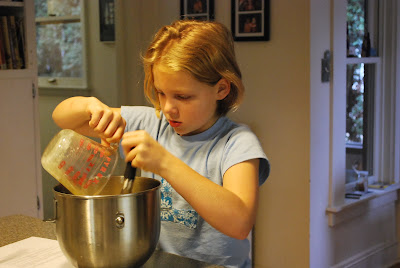A quick google search turned up this recipe for Authentic Delaware Chicken and Slicks. Although our kids generally dislike soup, this meal very much resembled the more successful chicken pie recipe from South Dakota.
You could certainly do this recipe in one day, but I stretched it over two. On Saturday, I made the stock and cooked the chicken. I briefly sauteed roughly cut onions, carrots, celery, garlic and parsnips in a little olive oil.

Then, I put a whole chicken on top of the veggies and covered with water. I added salt, pepper and thyme and simmered for about 2 hours. I removed the chicken and let it cool for a while before removing the meat from the bones. At this point, the stock was nice and rich. If you want to concentrate more flavor, you could put the bones back in the liquid to simmer longer.
On Sunday, I sauteed diced onions, carrots, celery in garlic with more thyme, salt and pepper. I added 8 cups of stock and brought it to a simmer. Meanwhile, I prepared the dough for the "slicks." I followed the recipe exactly here, and was rewarded with a nice soft, stretchy dough to work with.

I used a pizza cutter to cut the squares

I added the slicks to the stock to cook, then the reserved chicken to heat through. This made a nice, warming one-pot meal.

The dish turned out more soup-like than I was expecting, next time I will start with a bit less stock. The flavors, however were excellent! The "dumplings" were more like a hearty noodle. Both girls ate well. Lucy thought the slicks were a little slippery, but ate them happily after setting a couple on the side of the plate to dry out for a minute. Maia really liked them and asked for extra slicks in her dish after she ate the first ones.

After the holidays, we'll take on our next four: Idaho, Connecticut, South Carolina and Arizona.
Whatever holiday you celebrate, we wish you a season full of peace and light!















































